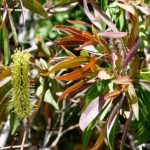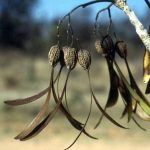TREE LIFE
May 1984
FORTHCOMING CALENDAR
Saturday May 6th : Botanic Garden Walk. Meet in the Car Park at 1045 for 1100 hours. Please note the change of day and time to cater for winter.
Sunday May 20th : By kind permission of the farm owner John Brown we will be visiting Dichwe Lemon Forest, Mhangura. This is an area of forest in a swampy “soak” containing not merely lemon trees but also forest giants like Khaya nyasica (the big tree of Chirinda forest). The lemons, which have become naturalized in the forest are thought to have come in on Arab or Portuguese trade routes. They are not indigenous to Zimbabwe. A bus has been arranged which will leave the Monomatapa Car Park at 0815 hours.
MATABELELAND NOTES
The April meeting was rained out – wonderful! For May we shall carry out our April programme – Hillside Dams, Upper at 0830 on May 6th.
BOTANIC GARDEN WALK 3RD APRIL 1984
There is so much we already know about the pea family I thought there would be little to add, but this proved so wrong when we examined this group with Tom Muller in the gardens this month. As the classification of the higher groups is in a state of flux I have explained the basic position in a root note which will be inserted as space allows, and here continue by discussing the family now called FABACEAE, the old sub-family PAPILIONOIDEAE of the LEGUMINOSAE. The pea flower is familiar to us all – a distinctive feature which we failed to see on the walk, but this only served as an encouragement to note the many vegetative features so distinctive in this family. The three legume families each have characteristic leaves, a feature first pointed out to me by Gill Masterson. The MIMOSACEAE generally have bipinnate leaves with fine leaflets, the CAESALPINIACEAE leaf is often pinnate with an even number of leaflets, paripinnate, whereas the FABACEAE usually are imparipinnate, a feature that is often emphasized by an unusually large terminal leaflet.
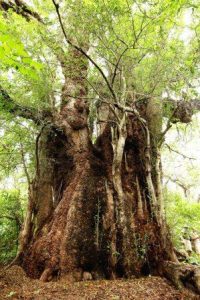
Xanthocercis zambeziaca. Photo: Bart Wursten. Source: Flora of Zimbabwe
Tom began the walk by examining the Nyala berry tree, Xanthocercis zambesiaca, one of the biggest trees in the South East Lowveld where it is often left uncut in irrigated fields. The imparipinnate leaf showed another family characteristic; the leaflets are neither opposite nor alternate, but sub-opposite on the rachis. Unlike other legumes this plant has a one seeded fleshy fruit that is edible; we may remember the other legume with a similar fruit, Cordyla africana of the Zambezi Valley.
In the gardens the Erythrina species seem so distinct, yet we often have trouble with them in the field. Starting with E. livingstonia, which has lobed leaflets and an unmistakable green trunk, Tom ranked the species in terms of seed size. This species has the largest seeds with a white mark on the red seed, all the rest have a black mark on the seed. The next largest seed occurs in E. latissima followed by E. abyssinica. E. latissima grows in granite kopjes becoming very common to the east. The branches are spiny and leaves bigger than E. abyssinica which often has a far corkier bark and grows in woodland. E. lysistemon has the smallest seeds in the series. Erythrina is one of the few legumes which have a trifoliate leaf but the large terminal leaflet is usually prominent.
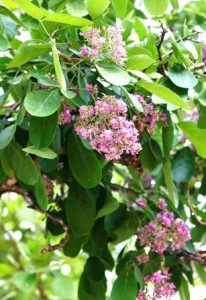
Lonchocarpus capassa. Photo: Bart Wursten. Source: Flora of Zimbabwe
We moved on to Lonchocarpus. The rain tree, L. capassa is a common sight in Zimbabwe with its large terminal leaflet. At some stage when we were having trouble with identifying coppice growth at Chegutu we spotted this tree by means of its stipules – small outgrowths on the leaf rachis associated with each leaflet, in contrast to stipules which grow at the base of the whole leaf. (Cronquist calls these stipellules, not stipulules as we have referred to them till now. These are also called stipels). Stipellules are in fact a characteristic of the FABACEAE not found in the other two legume families. When Tom tricked us all out by showing us the simple leafed L. nelsii which grows along vlei edges in the Kalahari sands of Hwange, it was most rewarding to find these stipellules half way up the leaf stalk of this one foliate leaf. This one foliate compound leaf often seems a ridiculous idea, but L. nelsii sometimes does have a true compound leaf. L. bussei has a complicated ecology, growing in jesse thicket and at the edge of pans in Malapati. We looked at Tom’s specimen from the schist kopjes of Nyamapanda road, and noted the swollen petiolules, glabrous leaves and battleship grey bark. The rarest species in the genus, L. eriocalyx grows on the schist hills of the Kariba basin and is difficult to grow. Tom’s small specimen was so young it had not developed the characteristic broad compound leaves.
It was refreshing to wander around the Zambezi Valley lowveld section, an area we have neglected for a long time now. Here we also discovered Dalbergia martinii of the deciduous dry layered forest of deep sands, another name for the jesse bush. Dalbergia also often has a lare terminal leaflet which is often off centre, and the genus tends to climb into surrounding vegetation. This species had such sticky pods some folk were averse to handling them, although we smelt the strange sweet scent.
The genus Pterocarpus has a distinctive venation, the veins in each leaflet run closely parallel. In the Zambezi lowveld section we examined P. brenani. I must confess I once spent two hours at Kariba unsuccessfully keying out this species’ pod within the Terminalia section. A highly embarrassing situation but then the leaves which are compound had not been collected. We noted the large shield like stipules. This species grows along the Zambezi escarpment as well as on the Chilojo cliffs above the Lundi. Another species P. antunesii is also found at Chilojo as well as in the mist forest at Victoria Falls and along the Zambezi. This is a multi trunked plant which becomes fluted and has a guava like bark. P. antunesii has the smallest leaves and fruit of all the Pterocarpus species. Tom described how in flower these trees are like bright yellow clouds on the escarpment. Another unassuming tree that suddenly bursts into bloom is P. rotundifolius. These are genuine two day wonders as the whole tree explodes with yellow flowers a few days after rain but the petals all fall within three days, earlier if it rains, then one waits for the next synchronous flowering. Apparently in the Matopos in full bloom is an unforgettable experience. The common subspecies is rotundifolius, but we looked at a northern tree subsp. polyanthus var martinii from the Mhangura area which has more, 4 to 8, pairs of leaflets than subsp. rotundifolius, which has only 1 t0 3 pairs. We are familiar with the mukwa, P. angolensis, with its hedgehog in a life belt seed pod.
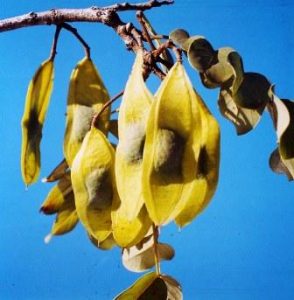
Xeroderris stuhlmanni. Photo: Mike Bingham. Source: Flora of Zimbabwe
Xeroderris stuhlmanni also has a blood red slash like the mukwa and somewhat folded leaflets but with a distinctive pod bearing railway line markings. This species grows in dry forest on karroo sand and alluvium as well as on termite mounds just off the Highveld.
To finish off the walk we examined both species of Ormocarpus, O. kirkii is the small caterpillar pod we encounter locally in dry woodland. The pinnate leaves are arranged in tight fascicles. While the light was fading fast we found Tom’s O. trichocarpum of the Bulawayo area, an unmistakable cousin of O. kirkii but with very small leaflets and apparently a bristly fruit. Thank you Tom, for yet another most rewarding evening.
-Kim .ST.J. Damstra
OUTING TO “LAWRENCES KOPJES”, CHEGUTU, SUNDAY 15TH APRIL 1984
This month we had a most enjoyable and rewarding outing to “Lawrence’s kopjes”, Chegutu, not only as guests of Peter and Heather Pulsen, but also on a wider scale, the guests of the Chegutu Branch. On our arrival we were treated to tea with delicious chocolate éclairs et.al. put on by Heather and the ladies of Chegutu. Thank you.
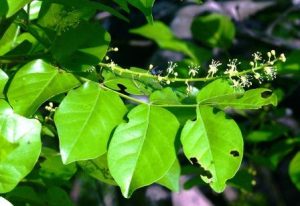
Lannea schweinfurthii var. stuhlmannii. Photo: Bart Wursten. Source: Flora of Zimbabwe
Having thus had a quick guzzle we then drove over a vlei up to a gate beyond which lay the area of our morning walk. After a brief run down on the farm (alt. 3 800 m) and a glance at the aerial photograph, we headed down in the direction of the dam. One of our first stops was to look at Lannea schweinfurthii var. stuhlmanii. With which we were able to compare what we believed to be Sclerocarya birrea, marula. This was an interesting exercise especially coming so soon after the précis of Geoff Archer’s talk on the subject in the Matabeleland Notes of last month’s Tree Life. We did conclude that the petioles of one were longer than those of the other making it Sclerocarya, and thus resolved the matter. Having now had a look in Trees of Southern Africa and also the specimens at the Botanic Garden, I have a sneaking feeling that we did not in fact see Sclerocarya. If you look at the book you are told that Lannea has 1 or 2 pairs of leaflets, occasionally 4, while Sclerocarya should have 7 to 13. This difference was certainly borne out by the specimens at the botanic garden, but I don’t think this was the case last Sunday. Also, the petioles on the Garden Sclerocaryas were noticeably long, in some cases as long as the leaflets themselves, making them markedly different from those of the Lanneas! Fortunately, we were also able to compare Lannea discolor, the obvious difference being the pale undersides of the leaflets of L. discolor.
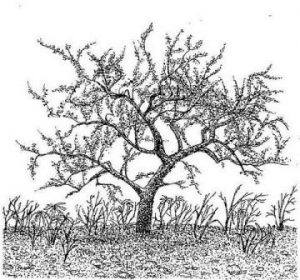
Commiphora pyracanthoides subsp. glandulosa. Artist: R. Herbert. Source: Flora of Zimbabwe
Moving on, we saw Commiphora pyracanthoides subsp. glandulosa a small tree with small yellowish leaves fascicled on the short lateral branchlets, and having a peeling bark rather like C. africana. At the Herbarium this was labeled G. glandulosa; but where one draws the line seems to be a matter of taste. The one diagnostic distinguishing feature between the two species or subspecies is the presence of glandular hairs on the outside of the calyx on C. glandulosa. We also later found C. africana, C. mollis and C. mossambicensis.
Still on the path leading to the dam, some of our party found Crossopteryx febrifuga in fruit. Much of this was regrowth carrying red leaves. Another more lowveld tree which we had seen before at Garamwe Farm was Berchemia discolor. The leaves are very dark glossy green especially on the upper surface and have a quilted appearance between the parallel arranged veins, which are themselves distinct being very pale, almost white in colour.
We passed a number of Combretum hereroense with their small leaves when I queried this later with Bob Drummond, he told me that this is no more significant than people with brown eyes and people with blue eyes. We are all of the same species! Under the heading of Combretums, we also saw C. collinum, C. imberbe, C. mollis, C. zeyheri and C. fragrans. This last was in fresh green leaf and showed the characteristic way in which the leaves come out in whorls of three, occasionally four, along the branches.
On the far side of the dam wall we came upon the first of a number of Grewias. Here was a strange one which we failed to identify but was identified at the Herbarium as G. praecox, the distribution map showing this to be mainly a denizen of the Zambezi Valley. The other one we saw here was suspected to be G. subspathulata but, if it was the right specimen, was casually identified as G. monticola on presentation at the Herbarium. Then we also saw, a bit later, G. flavescens with the unmistakable square fluted stem and branches. I see this is called the rough leafed Grewia. I wonder if anyone has noticed this before. I have not.
We were then led through scattered mopanes to a large anthill composed, obviously of clay soil atop of which was a very big Euphorbia ingens. The strange thing was that the branches tended to bend down as if wilting but then turned up abruptly at the tips which were covered in fresh fruits. I suspect that either old age had caught up with this specimen, or that the clay soil was producing this effect.
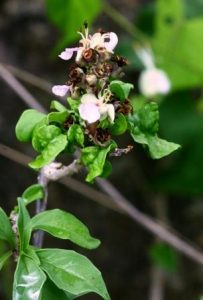
Clerodendrum wildii. Photo: Bart Wursten. Source: Flora of Zimbabwe
We then turned back and headed for a fair sized pod mahogany, Afzelia quanzensis, passing some low shrubs which we did not recognize. These were identified at the Herbarium as Cissus cornifolia, a wild edible grape. Under the Afzelia was what could only be Clerodendrum wildii complete with purple petioles and all, yet strangely, not a whiff of the unpleasant smell which we always associate with this tree!
We were then shown some enormous specimens of Manilkara mochisia, again really a lowveld inhabitant. Although the two big specimens were obviously dying off there was much encouraging regrowth of young trees. We were again able to see the ‘looping’ pattern of growth along the horizontal branches, something of a characteristic of the family SAPOTACEAE. Mimusops zeyheri, which we saw in the afternoon, will also, demonstrate this feature, but it wasn’t very clear on the one we saw.
In the close vicinity were some large bushes of Balanites aegyptiaca, with the greenish yellow thorny branchlets and the characteristic single pair of leaflets. Another busy scrambler in the same area was Capparis tomentosa the local relative of the European caper, still bearing the remains of the spherical fruit.
We were then introduced to Canthium rangula with paired thorns arranged in an opposite-decussate fashion – i.e. each pair at 90o to the pair immediately above and below. The paired leaves were on very short little branchlets, but with close observation it was still possible to see the tiny interpetiolar stipules diagnostic of the RUBIACEAE family. These were also seen on a much grander scale on the Canthium lactescens and I was able to demonstrate how this tree ‘lactates’ by squeezing the terminal bud causing a thick sticky milk to ooze out. Indeed, this was a day of many RUBIACEAE, seeing large numbers of Pavetta gardeniifolia, with the black bacterial dots visible in the leaves when held up to the light. Then there was no shortage of Vangueria infausta, Torenna neurophylla and also some specimens of Tricalysia angolensis.
During the morning some observant members collected Albizia amara with typical ultra fine leaflets, but also another specimen which appeared slightly different. This latter specimen was confirmed at the Herbarium as A. harveyi, the main difference being that the minute pinnules are more sickle-shaped. Our impression was that they were more gloss green, those of A. amara being a more yellow-green colour and more velvety. The other significant point is that A. harveyi, almost, has thorns. At the base of each petiole the persistent stipule developed into a sharp spine and can of course lead to confusion with acacia species.
In the afternoon we went round to the back of the kopje behind the house and in the area where we parked were thick stand of jesse composed mainly of Dichrostachys cinerea. Going up onto the hillside were a number of stranglers – some ankle high specimens of Haplocoelum foliolosum, which we last saw at the Watkin’s Stanley farm in 1982. Also last seen there were Hippocratea parvifolia, being more of a scrambler, the branchlets twisting into tendrils in order to hang onto the other vegetation around. We then admired the feats of three strangler figs, Ficus thonningii. One was taking over a very large Diospyros mespiliformis. The other, near the cattle dip was so large and obviously so old that any ‘host’ must have expired in years past beyond memory, now without trace. Further down in the jesse another was taking over a sausage tree, Kigelia africana. Through a hollow portion of the host trees, the fig had obviously found a path for an aerial root which had then swelled splitting the tree asunder.
It was near this last fig that we were shown another of the more unusual trees, Zanthoxylum chalybeum, Fagara chalybea. This has endless prickles on all parts including the leaves and the trunk where they turn into formidable bosses. This tree is perhaps more usually a liane, but this one was a respectable enough tree with an upright bole. Being of the RUTACEAE it has the yellow translucent dots in the leaves and gives off a lemon like smell when the leaves are crushed.
At the end of it this was a most rewarding day. I counted 91 ‘ticks’ on my card alone and there were too many to discuss each one above. There were a couple, e.g. Schrebera trichoclada which I only recorded once the mystery specimen had been identified at the Herbarium, thanks to John Ngoni and Bob Drummond.
Many thanks again to the Poulsens and Chegutu Branch members.
This was the first month for several years that we had to cancel our bus booking and make eleventh hour arrangements to share lifts and go by car. This was because, for a 36 seater bus we only received 15 bookings. This can be explained partly by the trip so closely preceding the Independence/Easter/School holidays and also the promise of an exciting though long trip to Dichwe the following month. However, I think the cost factor also played a major role. The steep fare was a direct consequence of a high quote for bus hire. So, if this trend continues it may well be more viable in future to dispense with a bus on selected routes. After all, the per person cost by car, petrol only was around $5, as against $13 for the bus. This month I think we have been lucky as a result of a ‘favour’ from Express Motorways.
-J.P. Haxen
ROOT NOTE : The Classification of the legumes is currently being altered, although the choice still seems to be a personal one. There is no doubt that there are three large groups of plants that all have a legume pod. Traditionally these have been classified as the three large sub-families of the LEGUMINOSAE : the MIMOSOIDEAE with few or no petals, e.g. Albizia and Acacia; the CAESALPINIOIDEAE with Cassia type flowers, including Brachystegia; and the PAPILIONOIDEAE with pea shaped flowers. Modern classification prefers all families to end in CEAE, and to take the name of a genus within the family. LEGUMINOSAE does neither and with a justified move to raise each of the sub-families to full family status we may as well get used to the changes now. The MIMOSOIDEAE and CAESALPINIOIDEAE become the families MIMOSACEAE and CAESALPINIACEAE after their respective genera Mimosa and Caesalpinia. The PAPILIONOIDEAE are doomed to change as there is no plant genus papilio, so this family is now called after the edible bean, faba and becomes the FABACEAE. The three families are combined in the same order, the Fababes, equivalent to the old group LEGUMINOSAE. This order is fairly close to the ROSIDAE, or rose order. The Fabales generally have alternate pinnate or bipinnate compound leaves, rarely palmate, trifoliate or simple, and are characterized by their nitrogen-fixing root nodules. They also have a distinctive range of rusts and smuts not usually found in other orders. The leaf and/or leaflets are often swollen near the base of their respective stalks. This is called a pulvinus and is kept turgid by being filled with water which holds the leaf in a special orientation with respect to the sun. In a few plants these pulvini lose their water when the plant is touched and the leaflets collapse and the leaf becomes flaccid, as in the sensitive plant, Mimosa pudica. It takes a while for the plant to pump water back into the pulvini so the leaves recover slowly until fully turgid. More often the swelling is present but the pulvinus is not functional – a hardy identification feature. The Fabales also have well developed stipules that are often modified into spines, as in some Acacia or for climbing. Although about two thirds of the plants in the order belong to the FABACEAE, this is generally a family of herbs, so this ratio is not reflected on the local tree list, where the MIMOSACEAE dominate in numbers. The Fabales are generally a very successful group of Zimbabwe, particularly due to their nitrogen fixing bacteria, which enrich the poorer soils like those at Hwange.
-Kim ST.J. Damstra
ROOT NOTE : For those interested in mathematics, plants provide some interesting facts in terms of phyllotaxis or leaf arrangement. Take a branch that shows a spiral leaf arrangement and trace a line from any given leaf to that leaf vertically above it following the natural spiral of the branch. Count the number of times the spiral goes around the stem and how many leaves are passed on the way including one of the end leaves in the number. For example in the yellow wood Podocarpus latifolius the spiral goes around the stem three times and it is the eighth leaf that is directly above. This can be expressed as a fraction of 3/8. If a number of different plants are examined it will be discovered that only a limited number of these fractions exist in nature. They form an interesting series 2/5, 3/8, 5/13, 8/21 …… This series, in which each numerator, or dominator is the sum of the two preceding numerators, or denominators, is known as a Fibonacci series. If these fractions are expressed as a decimal they tend towards a limit which is reached at 0,38197. In practical terms this value can be translated into a fraction of a circle, 360o, such that 0,38197 x 360o =137o30’ 28”. This is known as the ideal angle because if the angle between two successive leaves is set at this angle no two leaves would be directly above each other. A different set of Fibonacci numbers occurs in the cones of cycads and pines. If these were examined, two sets of spirals will be seen, one set going clockwise around the cone and the other anti-clockwise. One set of spirals is always steeper than the other and also has more rows. If the number of spiral running one way and the other way is expressed as a fraction, a new series of numbers emerges: 2/3, 3/5, 5/8, 8/13, 13/21 …… Most of the Encephalartos cones at the university have a 5/8 arrangement, although an 8/13 cone is also present. This series tends towards 0,61803. These fractions have been known for many years and has fascinated successive generations because these two numbers have a distinct relationship: 0,38170+0.61803 = 1 and 0,38197:0,61803 = 0,6803:1. This latter ratio demonstrates the solution to an interesting mathematical problem : “to divide a line into two parts such that the relationship between the smaller and the greater part is the same as the relationship between the larger part and the whole line.”
-Kim ST.J. Damstra
ROOT NOTE : Recently when I took a load of specimens into the Herbarium for identification Tom Muller, the Director, expressed interest in some of our finds and then proceeded to urge us to collect and bring in the seed/fruit of what we see He says that almost any species and quantity will be useful. Naturally, a note on when and where the seed was collected and perhaps a guess at the species will also help. The seed submitted may be propagated in the Gardens or may go into the Seed Exchange Unit for exchange with local and foreign individuals and bodies for the promotion of the Gardens and Conservation of trees in general. Tom feels that our outings will take on added purpose and I would certainly encourage this idea as it would be a fitting ‘payment’ for Tom’s efforts on all our Botanic Garden walks.
-J.P. Haxen
FINALLY : Some members will find an account enclosed for subs. Please regard this as a final reminder, for if we do not get your subs by the time the next issue goes in for typing, your name will be off the mailing list!
-PHILIP HAXEN CHAIRMAN


